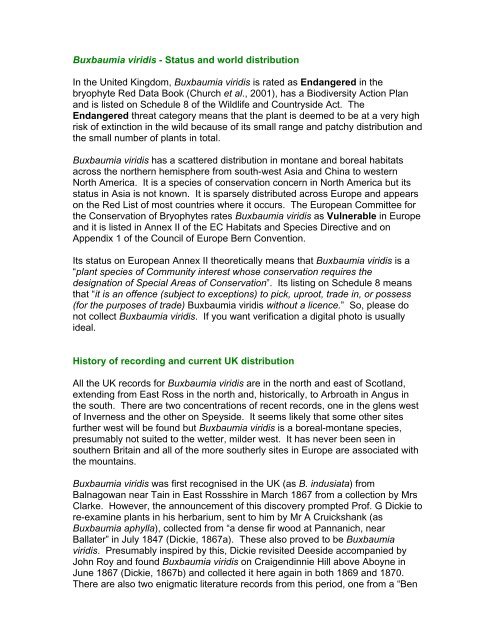Buxbaumia viridis leaflet - Plantlife
Buxbaumia viridis leaflet - Plantlife
Buxbaumia viridis leaflet - Plantlife
Create successful ePaper yourself
Turn your PDF publications into a flip-book with our unique Google optimized e-Paper software.
<strong>Buxbaumia</strong> <strong>viridis</strong> - Status and world distributionIn the United Kingdom, <strong>Buxbaumia</strong> <strong>viridis</strong> is rated as Endangered in thebryophyte Red Data Book (Church et al., 2001), has a Biodiversity Action Planand is listed on Schedule 8 of the Wildlife and Countryside Act. TheEndangered threat category means that the plant is deemed to be at a very highrisk of extinction in the wild because of its small range and patchy distribution andthe small number of plants in total.<strong>Buxbaumia</strong> <strong>viridis</strong> has a scattered distribution in montane and boreal habitatsacross the northern hemisphere from south-west Asia and China to westernNorth America. It is a species of conservation concern in North America but itsstatus in Asia is not known. It is sparsely distributed across Europe and appearson the Red List of most countries where it occurs. The European Committee forthe Conservation of Bryophytes rates <strong>Buxbaumia</strong> <strong>viridis</strong> as Vulnerable in Europeand it is listed in Annex II of the EC Habitats and Species Directive and onAppendix 1 of the Council of Europe Bern Convention.Its status on European Annex II theoretically means that <strong>Buxbaumia</strong> <strong>viridis</strong> is a“plant species of Community interest whose conservation requires thedesignation of Special Areas of Conservation”. Its listing on Schedule 8 meansthat “it is an offence (subject to exceptions) to pick, uproot, trade in, or possess(for the purposes of trade) <strong>Buxbaumia</strong> <strong>viridis</strong> without a licence.” So, please donot collect <strong>Buxbaumia</strong> <strong>viridis</strong>. If you want verification a digital photo is usuallyideal.History of recording and current UK distributionAll the UK records for <strong>Buxbaumia</strong> <strong>viridis</strong> are in the north and east of Scotland,extending from East Ross in the north and, historically, to Arbroath in Angus inthe south. There are two concentrations of recent records, one in the glens westof Inverness and the other on Speyside. It seems likely that some other sitesfurther west will be found but <strong>Buxbaumia</strong> <strong>viridis</strong> is a boreal-montane species,presumably not suited to the wetter, milder west. It has never been seen insouthern Britain and all of the more southerly sites in Europe are associated withthe mountains.<strong>Buxbaumia</strong> <strong>viridis</strong> was first recognised in the UK (as B. indusiata) fromBalnagowan near Tain in East Rossshire in March 1867 from a collection by MrsClarke. However, the announcement of this discovery prompted Prof. G Dickie tore-examine plants in his herbarium, sent to him by Mr A Cruickshank (as<strong>Buxbaumia</strong> aphylla), collected from “a dense fir wood at Pannanich, nearBallater” in July 1847 (Dickie, 1867a). These also proved to be <strong>Buxbaumia</strong><strong>viridis</strong>. Presumably inspired by this, Dickie revisited Deeside accompanied byJohn Roy and found <strong>Buxbaumia</strong> <strong>viridis</strong> on Craigendinnie Hill above Aboyne inJune 1867 (Dickie, 1867b) and collected it here again in both 1869 and 1870.There are also two enigmatic literature records from this period, one from a “Ben
















